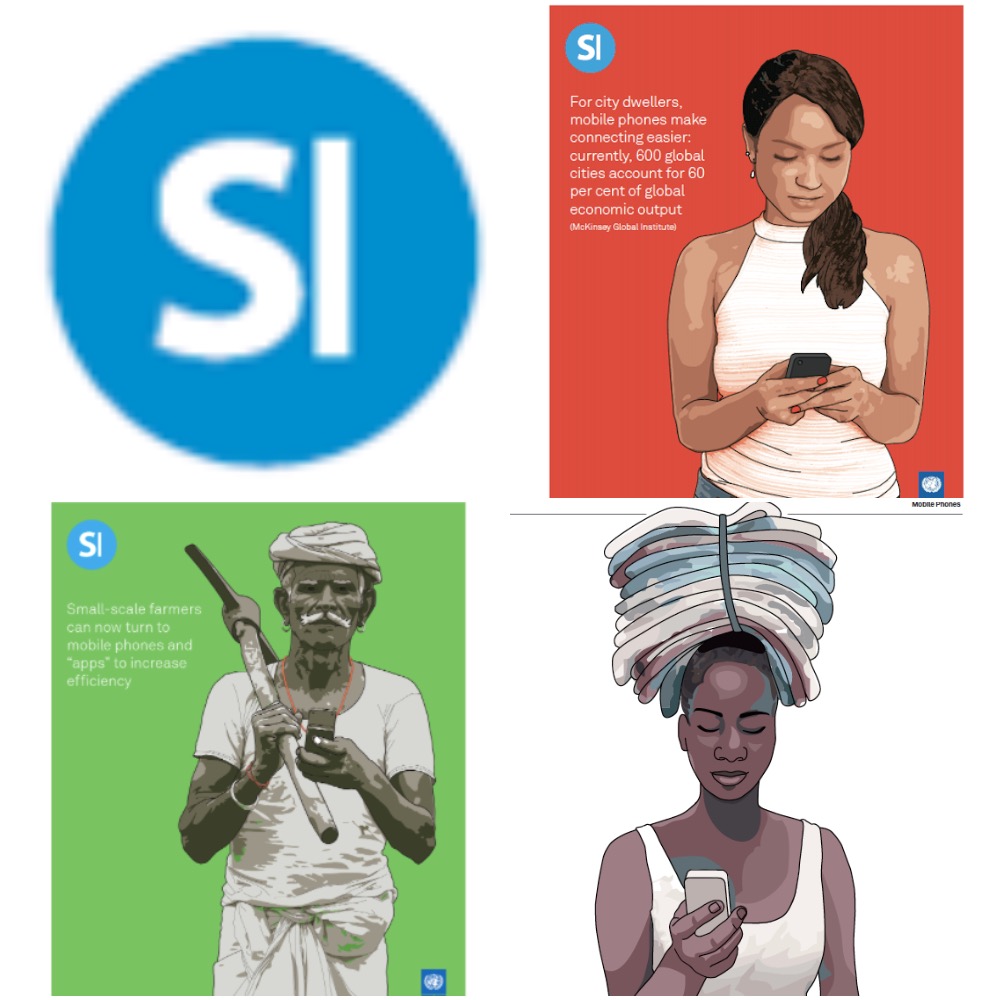Mobile Phone Peacekeeping
 Tuesday, June 16, 2015 at 11:50AM
Tuesday, June 16, 2015 at 11:50AM 
Last month UN Secretary-General Ban Ki-moon pointed out the urgent need for interesting and relevant content to attract Africans to the internet. Official statistics can make for grim reading: the continent has less bandwidth than Ireland (World Economic Forum). While it is true Africa is restricted by serious technological and economic disadvantages, African ingenuity, creativity and hard work are bypassing these impediments to get things done nonetheless. While word has got out about the impressive take-up of mobile phones in Africa, the new world of Web 2.0 is also spawning a new generation of inspiring African technology whizzes transforming perceptions and grabbing the world’s attention.
Alongside the combination of innovation and affordability that has made Africa the fastest growing mobile phone market in the world, there is a home-grown technology boom underway: “African firms are already participating in the forefront of technological developments and investment opportunities,” according to the Africa Competitiveness Report 2007.
Powerful and easy-to-use Web 2.0 tools are being used by Africans during times of crisis. Among the most innovative are “mash-ups” – a term once used to refer to the musical style of combining two or more song tracks that has come to mean the blending together of various software programmes. These Web 2.0 software mashups combine weather information, maps, webcams, population figures, even restaurant locations – in fact any application that can be easily added to a website. The possibilities are limitless, and this is what is causing so much excitement for development in the South.
In Kenya, a website called Ushahidi (Swahili for testimony), is using ICT (information and communications technology) and mobile phones to save lives in the post-election violence. People on the ground can send in live situation reports and alerts through the web and mobile phones to the website, which then maps violence in real time.
According to the site’s originator, Kenyan Ory Okolloh, Ushahidi.com “is a tool for people who witness acts of violence in Kenya in these post-election times. You can report the incident that you have seen, and it will appear on a map-based view for others to see.”
It has been put together by Kenyan web developer David Kobia (also the developer of Mashada, an online African community), and inspired by African blogger Erik “Hash” Hersman and other Kenyan bloggers and activists.
At the start of the violence, Okolloh had put out a message for help on the web. “Google Earth supposedly shows in great detail where the damage is being done on the ground,” Okolloh said on the site. “It occurs to me that it will be useful to keep a record of this, if one is thinking long-term. For the reconciliation process to occur at the local level the truth of what happened will first have to come out. Guys looking to do something – any techies out there willing to do a mashup of where the violence and destruction is occurring using Google Maps?”
The website came together quite quickly: after initial discussions amongst the team of five on January 5, it was live by January 9 (they estimate 40 hours for development and 20 to 30 hours for testing and promotion).
For others who want to do the same, the key is good relationships, not necessarily technology, the Ushahidi team says. “My advice is to make sure you’re well networked with the right people before something like this is needed,” said Erik Hersman, who runs Afrigadget and White African blogs. “By the time you need a site like Ushahidi, it’s too late to start making connections, it’s time to build … everyone needs the passion to fulfill the vision of the project.”
And to keep it going is not that time consuming, they say. The largest part of their time is spent keeping in contact with NGOs and a volunteer network in Kenya, and verifying the information.
“My advice would be to keep things as simple as possible.,” said Kenyan David Kobia. “Mashups are basically methods of relaying data, so simplicity is absolutely key.”
“The feedback has been phenomenal. Ushahidi’s graphical representation of events illustrates to some degree the magnitude of the events to people outside Kenya. The enormity of the situation can be understood better as events unfold, keeping everyone in the loop with a point of reference – people tend to become apathetic when regular news moves from the front page.”
Ushahidi has been praised for providing NGOs, the international community and humanitarian agencies with vital information they can use to help people.
Kobia has also launched a new mashup to promote Kenyan unity called ihavenotribe.
AfricaNews.com has also been turning to mobile phones to get the news out on the Kenyan crisis. The agency’s reporters use internet-enabled mobile phones with portable keyboards to transmit photos, video and text for reports. All of it is uploaded to the www.africanews.com website. Some are calling this the first use of mobile phone journalism in Africa.
By David South, Development Challenges, South-South Solutions
Published: February 2008
Development Challenges, South-South Solutions was launched as an e-newsletter in 2006 by UNDP's South-South Cooperation Unit (now the United Nations Office for South-South Cooperation) based in New York, USA. It led on profiling the rise of the global South as an economic powerhouse and was one of the first regular publications to champion the global South's innovators, entrepreneurs, and pioneers. It tracked the key trends that are now so profoundly reshaping how development is seen and done. This includes the rapid take-up of mobile phones and information technology in the global South (as profiled in the first issue of magazine Southern Innovator), the move to becoming a majority urban world, a growing global innovator culture, and the plethora of solutions being developed in the global South to tackle its problems and improve living conditions and boost human development. The success of the e-newsletter led to the launch of the magazine Southern Innovator.

Follow @SouthSouth1
Google Books: https://books.google.co.uk/books?id=waeXBgAAQBAJ&dq=Development+Challenges+February+2008&source=gbs_navlinks_s
Slideshare: http://www.slideshare.net/DavidSouth1/development-challengessouthsouthsolutionsfebruary2008issue
Southern Innovator Issue 1: https://books.google.co.uk/books?id=Q1O54YSE2BgC&dq=southern+innovator&source=gbs_navlinks_s
Southern Innovator Issue 2: https://books.google.co.uk/books?id=Ty0N969dcssC&dq=southern+innovator&source=gbs_navlinks_s
Southern Innovator Issue 3: https://books.google.co.uk/books?id=AQNt4YmhZagC&dq=southern+innovator&source=gbs_navlinks_s
Southern Innovator Issue 4: https://books.google.co.uk/books?id=9T_n2tA7l4EC&dq=southern+innovator&source=gbs_navlinks_s
Southern Innovator Issue 5: https://books.google.co.uk/books?id=6ILdAgAAQBAJ&dq=southern+innovator&source=gbs_navlinks_s

This work is licensed under a
Creative Commons Attribution-Noncommercial-No Derivative Works 3.0 License.
 Africa,
Africa,  David South,
David South,  Kenya,
Kenya,  Ushahidi,
Ushahidi,  Web 2.0,
Web 2.0,  cell phones,
cell phones,  innovation,
innovation,  mash-ups,
mash-ups,  mobile,
mobile,  mobile phones,
mobile phones,  mobiles,
mobiles,  technology in
technology in  Cities,
Cities,  Data,
Data,  David South Consulting,
David South Consulting,  Development Challenges, South-South Solutions,
Development Challenges, South-South Solutions,  Digital,
Digital,  GSSD Expo,
GSSD Expo,  Global South-South Development Expo,
Global South-South Development Expo,  ICT4D,
ICT4D,  Media,
Media,  Peacekeeping,
Peacekeeping,  Solutions,
Solutions,  Southern Innovator Magazine,
Southern Innovator Magazine,  UN Innovator Stories,
UN Innovator Stories,  UNDP,
UNDP,  UNDP Innovator Stories,
UNDP Innovator Stories,  UNOSSC,
UNOSSC,  United Nations
United Nations